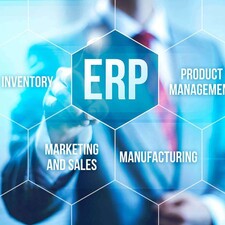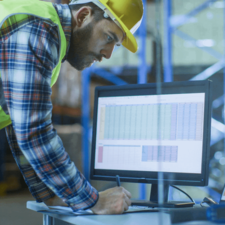Blog
What is a Smart Factory and its Role in Manufacturing?

Summary
The smart factory is defined as a factory where physical production processes and operations are combined with digital technology, smart computing and big data to create a more opportunistic system for companies that focus on manufacturing and supply chain management. The smart factory are an aspect of Industry 4.0, a new phase in the Industrial Revolution that focuses heavily on real-time data, embedded sensors, connectivity, automation, and machine learning.
As factories evolve in light of the data revolution, businesses need to rethink how they handle everything from automation strategies to workforce development tactics. Along the way, manufacturers will need modernized tools, including robust, flexible enterprise resource planning systems as a data and transactional backbone, that help them adapt quickly as they build toward a smart-factory future.
What Does a Smart Factory Look Like?
The easiest way to envision a smart factory is in comparison to a more traditional, but still modernized, production environment. As manufacturers have embraced automation in today's climate, many have automated systems in various parts of their operations. They may have tools to automate elements of the supply chain, such as on-line production machinery, barcode scanners, drones that help with picking, or similar tools. At the same time, a production line may be automated so an item can go through various phases of manufacturing without human intervention using robotics. Testing and quality control could feature cameras and sensors that automate much of the work there as well.
But in many factories, each of these automated processes is disconnected with one another, requiring frequent human intervention to handle transitions between various phases of operations. What's more, the lack of connectivity between machines and across lines of business means that human workers are constantly analyzing disparate data sets and reports to identify problems and potential areas for efficiency gains. The factory of the future is one in which these disparate systems are no longer isolated. Data and process workflows will be optimized across lines of business, from the warehouse to the shop floor and the sales office.
The smart factory brings the fourth industrial revolution to bear by driving more intelligent manufacturing. Some ways this can play out include:
- Integrating real time production data with predictive inventory and purchase management systems so material supply can align more optimally with the production schedule.
- Using machine learning to automatically analyze data gathered by sensors and monitoring devices on equipment and recognize opportunities for efficiency gains. From there, the software can actually change the parameters machines use to function, automatically putting process improvements into place.
- Leveraging robotics solutions at a deeper level, such as drones to handle repetitive tasks that previously required human intervention.
These are just three examples of how the smart factory takes shape. But the movement boils down to a simple idea: Instead of having isolated automation with frequent human intervention, the smart factory eliminates barriers between all phases of operations to automate data analysis and operational workflows more deeply in a single connected ecosystem.

Where Does the Smart Factory Movement Stand?
Businesses are moving quickly to embrace the smart factory movement. It is difficult to say when the intelligent production environment of the future will be the new normal, but businesses are already working toward this future. According to a MarketsandMarkets study, the smart-factory sector will achieve a value of $153.7 billion in 2019. The market will rise at a compound annual growth rate of 9.76% between 2019 and 2024, climbing to a value of $244.8 billion at that time. According to the study, the rapid growth of the smart factory market is directly linked to a wide range of technologies and trends that are coming together to drive disruption in manufacturing.
These include:
- The increased use of internet of things solutions and industrial robotics.
- The heightened emphasis on regulatory compliance in the sector.
- The deepened deployment of automation solutions.
Ultimately, the smart factory movement is dependent on systems that blend digital and physical capabilities, and the result is a major emphasis on optimal operational environments.
What Is the Path to Smart Factory Maturity?
Many businesses have been working toward smart-factory innovation, even if that isn't what they set out to do when they launched digital modernization projects. But as companies work to take their isolated digital and automation initiatives and turn them into tightly integrated systems, the path can get tough to follow. With so many interconnected systems that need to be put in place, it can be difficult to identify the best way forward. Forbes offered some guidance on this issue, highlighting a four-stage maturity cycle businesses can use to guide their smart factory efforts.
According to Forbes, the first level of smart-factory maturation is where many businesses are today. They have digitized and automated enough operations that they are creating a great deal of data about operations, but that information is often stuck in silos and difficult to take action on.
The second level involves progressing from having available data to making that information accessible. In this environment, dashboards and visualization tools make data from disparate systems easier to get to. However, getting proactive with data still requires jumping through hoops.
The third level of the maturity model, as defined in the Forbes report, involves getting proactive with operations. This means employing preventative approaches to solving problems. In many cases, achieving this goal requires not only deep data integration across areas of operations, but tools like artificial intelligence that make it easier to identify patterns and forecast issues that may arise. There is still a great deal of human intervention happening in this setup, as the AI is present to inform humans, not take action immediately.
The machine-driven action is what makes the fourth level of Forbes' smart factory model stand out. In this tier, machine learning systems don't just identify patterns, they interact with software and equipment to make adjustments automatically.
Looking for new a ERP system? Download the guide: Selecting an ERP System in 7 Easy Steps
ERP platforms are critical in helping businesses on this journey. Deepening automation is reliant on data connectivity across lines of business. Modern ERP solutions, such as abas, position organizations to streamline data communication between departments and automate key workflows so they can eliminate inefficiencies and take strides to the smart factory of the future.
Contact abas ERP today to learn more.


